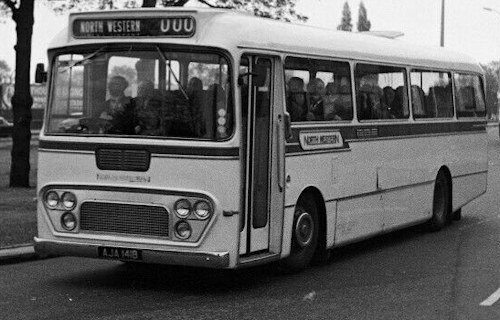Leyland Leopard
 |
|
|
Manufacturer |
Leyland Motors |
|
Class |
Commercial vehicle |
|
Type |
bus |
|
Production period |
1959 to 1982 |
|
Engine |
11.1 litres |
The Leyland Leopard was a bus chassis of the British commercial vehicle manufacturer Leyland Motors . built from 1959 to 1982.
History
The Leyland Leopard engine is situated in the middle of the vehicle. It was originally designed as a replacement for the popular Leyland Tiger Cub, but both types were constructed in tandem for more than ten years. The usage of the more powerful O.600 diesel engine was the main change from the Leyland Tiger Cub. Later Leopards were fitted with the O.680 engine, which had a displacement of 11.1 litres.
In 1950, in the United Kingdom, the maximum length for buses wasraised to about 9.1 meters (30 feet). The initially manufactured versions met these specifications. Later, when the maximum permitted length was raised again, Leyland also produced the chassis in versions with a length of 10 or 11 meters. Together with the Tiger Cub , the Leopard almost completely displaced the Royal Tiger from the British market in a short time. With more than 1700 produced buses, the Leopard was one of Leyland's most successful bus models, but could not build on the sales successes of the Tiger Cub .
The Leyland Leopard was replaced from the early 1980s by Leyland Tiger . Its main competitor in the British market was the AEC Reliance although the Associated Equipment Company also belonged to the Leyland Group. The manufactured chassis received in the name initially the abbreviation L1 or L2 , later the abbreviation PSU3 (11 m in length) or PSU4 (10 m in length). The L1 and L2 differed only by the construction of the frame back, while the latter was more suitable for the construction of coaches, the former was primarily intended for the construction of scheduled buses.
Series production began in 1959 after the prototypes were unveiled at the 1959 Scottish Motor Show. Equipped were the buses with the six-cylinder diesel engineO.600 from Leyland with 9.8 l displacement and 125 bhp, The pneumatically assisted manual four-speed gearboxes synchronized the third and fourth gears. Later, the O.680 with 11.1 l displacement and 180 bhp and semi-automatic transmission was installed. The engine was located in the middle underfloor. Optionally, a rear axle with countershaft and pneumatic brakes on all four wheels could be ordered. The chassis was air-sprung. Until the 1980s, it was common for chassis and bodies for buses were made by different manufacturers. The chassis produced by Leyland were therefore completed by bodywork companies . Part of the buses received superstructures from Leyland's subsidiary Charles H. Roe in LeedsOther major bodybuilders include Alexander , Beadle , Burlingham , Crossley , Duple , East Lancs , Harrington , Marshall , Metro Cammell , Northern Counties , Nuttall , Park Royal , Plaxton , Strachan , Willowbrook and Weymann . Both coaches and city buses were built.
In England, the subsidiaries of British Electric Traction (BET) became major customers of the Leopard . For city buses and multi-purpose vehicles, which could be used both as a travel and as a city bus, BET developed a standard design for the superstructures. The superstructures themselves were primarily from Marshall and Willowbrook , occasionally also from Weymann and Metro-Cammell . Another key customer for the Leopard in England was Barton Transport of Chilwell near Nottingham . BartonOperated a fleet of 200 buses with Panorama Elite and Supreme Constructions by Plaxton . Barton used the buses for all types of passenger transport, so these buses were equipped with a wider, double-leaf door. The body styles themselves were called Express . At that time, the British government subsidized the purchase of buses if they met certain specifications and were used for a prescribed share in local traffic. Other operators also used these grants and procured Leyland Leopard manufactured to these specifications .
In Scotland, many buses were purchased by subsidiaries of the Scottish Bus Group and mostly equipped with a construction of Alexander ( Y type ) both as a travel and as a city bus.The Irish company Córas Iompair Éireann (CIÉ) also bought a large number of buses and provided them as a rule with a built in their own workshops construction.
The northern Irish counterpart to CIÉ , the Ulster Transport Authority (UTA) and its successor Ulsterbus , procured the buses with the X -type construction of Alexander. For a period of 40 years, the leopard on Northern Irish roads was a common sight. During the riots in Northern Ireland, a total of 228 leopards were stolen from their depots and publicly destroyed.The British military also deployed a number of leopards . The bus was exported to Australia and New Zealand.
Manuals
-
Leyland Motors Ltd Previous 15 / 40 Next
